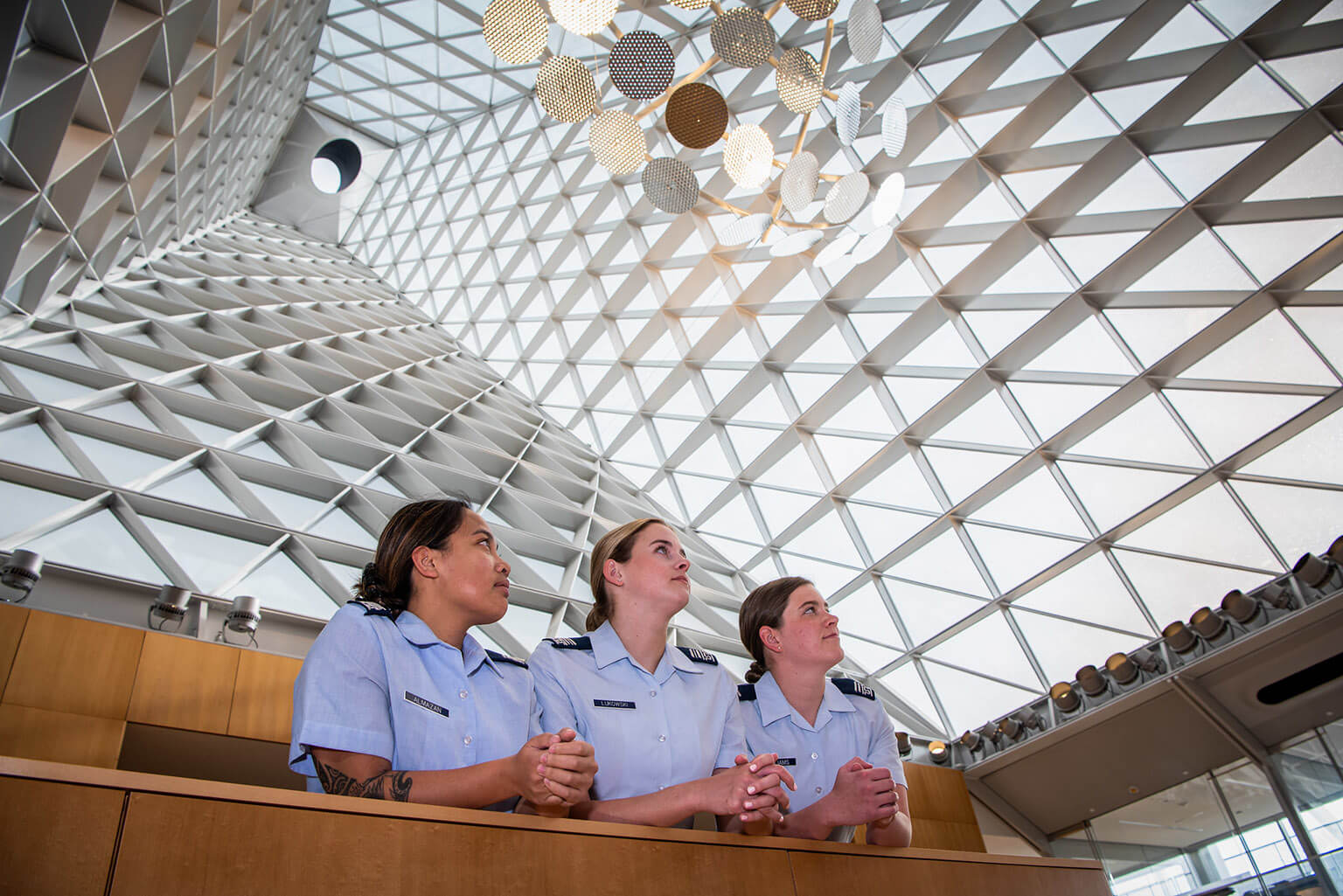Cadets create Academy “green tour”
 Cadets first class Ardent Almazan, Emily Lukowski and Maddie Williams (left to right) admire the sustainability features in Polaris Hall, a LEED Gold-certified building, at the U.S. Air Force Academy, April 4, 2023. The cadets developed a green tour of the Academy for their Geospatial capstone. (U.S. Air Force Photo/Justin Pacheco)
Cadets first class Ardent Almazan, Emily Lukowski and Maddie Williams (left to right) admire the sustainability features in Polaris Hall, a LEED Gold-certified building, at the U.S. Air Force Academy, April 4, 2023. The cadets developed a green tour of the Academy for their Geospatial capstone. (U.S. Air Force Photo/Justin Pacheco)
By Blaire Brush
U.S. Air Force Academy Strategic Communications
U.S. AIR FORCE ACADEMY, Colo. - You can now take a “green tour” of the U.S. Air Force Academy, thanks to three senior cadets’ geospatial sciences capstone project.
Cadets first class Emily Lukowski, Maddie Williams and Ardent Almazan spent this semester researching and mapping the existing and planned sustainability features at the Academy.
“Before we started this project, we didn’t realize that so many of our facilities had so many sustainability features. You just don’t see many of them,” said Almazan, who is slated to go into U.S. Space Force operations after she graduates this June.
Sustainable Features
Turns out there are several sustainability projects that save money, provide energy efficiency and preserve natural resources each year. They include the solar array near the South Gate providing electricity, wastewater recycling for irrigation saving on water consumption, and a geothermal system at the cadet field house cutting energy costs as well as greenhouse gas emissions. Among the planned projects are renovations Sijan Hall to reduce energy consumption, updating landscaping to be more water-efficient by planting native grasses in select locations, improving the recycling program and installing electric vehicle charging stations.
The Academy’s facility planning and sustainability manager, Daniela Lawrence, worked with the cadets on the project. She says sustainability is recognized as a national security issue.
“To assure its mission for future generations, the Academy needs to increase its resiliency, minimize costs and decrease waste,” Lawrence said. “Today the Academy recognizes there is a need to create best sustainability practices to ensure it meets the needs of the present without compromising its mission in the future.”
Future Benefits
The cadets say this project will not only be beneficial to the Academy’s future, but their future as officers.
“We learned how to dig for information, decipher a ton of data and determine what was important as it related to our project,” said Lukowski, a future pilot.
Their professor, Dr. Amélie Davis, said that the discovery process is usually the most difficult for students, but also the most rewarding and useful.
“It’s a great simulation for their future,” Davis said. “As officers, they’re going to be asked to go find a solution and they won’t know what the answer is when they start. They might as well learn what works and what doesn’t work in a classroom setting with someone overseeing what they’re doing and helping guide them.”
Williams said she can see how this experience will help her in her future as an intelligence officer in the U.S. Air Force.
“I think it will really help me in intel, where you’re given a ton of information and you have to narrow down what is important,” said Williams.
Other geospatial sciences projects
After the cadets sifted through the data, they created a green tour map with the Story Maps web tool, allowing them to bring together a lot of what they’ve learned throughout their geospatial sciences and core curriculum. Other capstone projects being completed by cadets in Dr. Davis’ class include an energy dashboard visualizing gas and electric usage at each building at the Academy, a water runoff evaluation of 40 years of Colorado Springs’ urbanization, and a navigation and mapping plan for Fairchild Hall, among others.